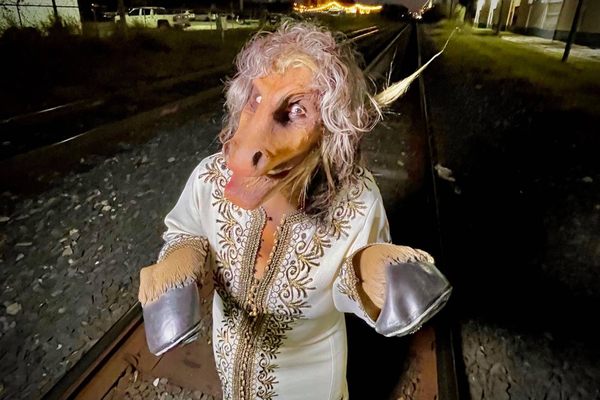Death as a Woman: The Accabadora of Sardinia
In Sardinian folktales, an older woman gives those at death’s door a nudge. But was she real?
In Sardinian author Michela Murgia’s 2009 novel Accabadora, a young girl named Maria is adopted by Bonaria Urrai, the respected village seamstress—and an angel of death. Little Maria wonders where Urrai disappears at night, never imagining that she hurries through narrow streets under the cloak of darkness, chanting prayers as she slips into the home of a villager lingering near death to finish the job.
Murgia’s seamstress character is a modern reimagination of the folk figure of the accabadora, sometimes spelled S’accabadora, who is described in dozens of traditional Sardinian tales. The older woman, with a black lace shawl draped over her head, is said to walk with her mallet doubling as a cane to the home of the dying. No family members are present, but they have left the door open for her. She turns around holy statues so they will not see what happens next. Then she takes her mallet to the person’s temple, delivering a brutal but swift death. It fits her name, “she who finishes” in Sardinian.
Written mentions of the accabadora first appear in the 17th century, where she is cast as a murderer. These folktales date to a time when Sardinia—an island 120 miles from the Italian mainland—was a socially conservative, highly patriarchal society dominated by the Catholic Church. Modern, feminist re-examinations like Murgia’s are now challenging these long-entrenched views.

As in Murgia’s fictional account, scholars such as Montclair State University’s Gina Miele argue that the accabadora was no villain; rather, she was villainized by the Church. While it’s unclear whether any Sardinian women actually acted as accabadoras—Miele believes there were women who carried out these “good deaths” but evidence is scant—the folk figure was culturally important to the community.

In folktales, the accabadora’s job is to release those lingering on the threshold of death. In addition to this task, the accabadora also often practices midwifery and healing, tasks also reserved for older women with deep knowledge of herbal remedies and other folk medicine. As such, the accabadora holds immense power in the stories, but this power comes at a great price: She commits euthanasia, a mortal sin that, in Catholic teaching, damns her soul.
“The mystery around her I think is partially because it was done in secrecy, because it had to be done in secrecy,” Miele says.
Christina Welch, a scholar of religion and death studies at the University of Winchester, believes that the accabadora’s ugly, old appearance in many folktales may be a manifestation of the Church’s condemnation of her work, as well as the patriarchal society’s devaluing of older women and traditional “women’s work.”
But there’s a key element in many accabadora folktales: Her killings were seen as socially “good deaths” of individuals who, after long and full lives, were ready for death. “She only comes in after the priest has done his bit. You know, these people are fully confessed, ready to go, she just speeds them on their way,” says Welch.
In most folk traditions, villains kill people who otherwise would have had long years of life ahead of them. The accabadora is more of a closer, performing a thankless task necessary to achieve resolution. This job, says Miele, is consistent with other roles traditionally reserved for women, including bringing children into the world and preparing the dead for burial.
Miele is writing a book about accabadora folklore and the women who may have performed the role in real life, perhaps as recently as the mid-20th century. Women “bring life in, we heal life,” Miele says. “We mourn and cant and chant as it is gone, and we are the ones, unfortunately, who frequently have to let life go.”
Welch sees an interesting juxtaposition that may help explain why the accabadora was so villainized, despite performing a critical role: Her activity could have been seen as encroaching on traditionally masculine territory.
“If you think about patriarchal society, it was men that would do the killing,” Welch says. “Men that would go out to war, men that had the power over things, and with the Church, men had the power over life and death and what happened after death. And yet here you have a woman who’s taking on aspects of that role.”
Scholars and even many Sardinians disagree about whether any women really did slip through the village streets at night, mallet in hand. But the folk figure of the accabadora endures, now with renewed respect from a small but passionate group of scholars determined to cast her in a different light.
“She finished a life, she doesn’t take away a life,” says Miele. “So the work of the accabadora, for me, is sacred work.”















Follow us on Twitter to get the latest on the world's hidden wonders.
Like us on Facebook to get the latest on the world's hidden wonders.
Follow us on Twitter Like us on Facebook